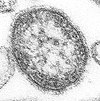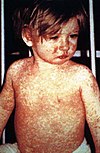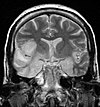| VideoWiki/Measles (Tutorial) | |
|---|---|
| Link to Commons | |
| Steps for video creation | |
| Step 1 | Preview my changes (10 sec) |
| Step 2 | Upload to Commons (10 min) |
Definition
Measles is a highly contagious infectious disease, caused by the measles virus.[1][2] It is also known as rubeola.

vs Rubella and Roseola
not to be confused with Rubella, (German measles) and roseola, which are different diseases, caused by unrelated viruses.[3]

Onset of illness
Symptoms usually develop 10–12 days after exposure to an infected person, and last 7–10 days.[4][5]

Initial symptoms
Initial symptoms typically include, fever, often greater than 40 °C (104 °F), cough, runny nose, and inflamed eyes.[1][6]

Koplik's spots
Small white spots, known as Koplik's spots, may form inside the mouth, two or three days after the start of symptoms.[6]

Rash
But the classic sign is a red (flat) rash, which usually starts on the face three to five days after the start of symptoms, and then spreads to the rest of the body.[6]

Common complications
About 7% of cases have complications, including diarrhea, middle ear infection, and pneumonia.[7]

Less likely complications
Less commonly, seizures, blindness, or inflammation of the brain, may occur.[4][7]

Cause
Measles is an airborne disease, which spreads very easily, through the coughs and sneezes of infected people.[4]

Other ways to spread disease
It may also be spread through contact with saliva, or nasal secretions.[4]

Contagiousness
It is so contagious that a single infected person will spread it to nine out of ten non-immune people who live with them.[7]

Duration of contagiousness
One reason is that it can be spread four days before a rash develops, and continue for four days after the start of the rash.[7]

Immunity
Fortunately, most people do not get the disease more than once.[4]

Diagnosis
Testing for the measles virus in suspected cases is important, for public health efforts.[7]

Prevention
The measles vaccine is effective at preventing the disease, and is often delivered in combination with other vaccines.[4]

Vaccine effectiveness
Vaccination resulted in a 75% decrease in deaths from measles between 2000, and 2013, with about 85% of children worldwide being currently vaccinated.[4]

Treatment
Once a person has become infected, no specific treatment is available,[4] but supportive care may improve outcomes.[4]

Supportive care
This may include oral rehydration solution (slightly sweet and salty fluids), healthy food, and medications to control the fever.[4][5]

Antibiotics
Antibiotics may be used, if a secondary bacterial infection such as bacterial pneumonia occurs.[4]

Vitamin A
Vitamin A supplementation is also recommended in the developing world.[4]

Epidemiology
Measles affects about 20 million people of all ages per year,[1] primarily in the developing areas of Africa, and Asia.[4][8]

Preventable deaths
It is one of the leading vaccine-preventable disease causes of death.[9][10]

Decrease in deaths
In 1980, 2.6 million people died of it,[4] but by 2014, global vaccination programs had reduced the number of deaths to 73,000.[11][12]

Increase in 2017
Rates of disease and deaths, however, increased in 2017 due to a decrease in immunization, and may be as high as 10% in people with malnutrition.[4]

Greatest risk
Most of those who die from the infection are less than five years old.[4][13] The overall risk of death among those infected is about 0.2%.[7]
